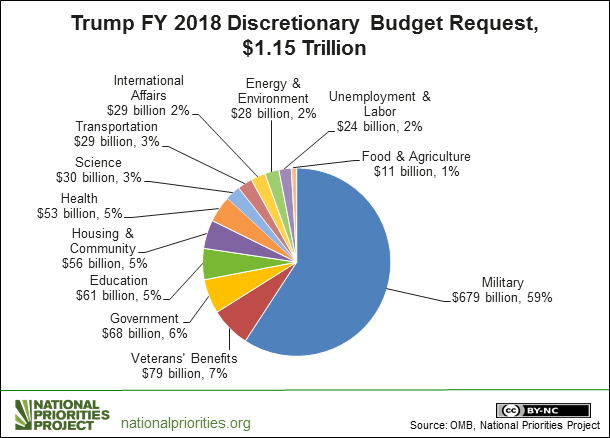Trump’s Budget Wars: War on the Poor, and Just Plain War
By
Lindsay Koshgarian
Posted:
|
Budget Process,
Military & Security,
Social Insurance, Earned Benefits, & Safety Net

We knew some of what to expect in President Trump’s first full budget proposal, based on his first budget blueprint and foreboding media stories. What we didn’t know was the full extent of whom Trump’s budget would seek to help, and at what cost.
War on the Poor: Trump’s budget declares war on those struggling to make it, regardless of income. The Trump budget makes massive cuts to Medicaid, food stamps, federal student loans, children’s health insurance, disability insurance and more.
Just Plain War: The United States military budget is already higher than at any point during the hyper- militaristic Reagan years. Trump’s proposal is to ramp this spending up even further, all while making drastic cuts to diplomacy and foreign aid programs that work to head off conflicts around the world. In the absence of any clear, overarching foreign policy strategy, this combination is asking for war.
And it keeps getting worse: after gutting these programs in 2018, Trump wants to keep the cuts going for the next ten years. A discretionary domestic cut of ten percent – and as high as thirty percent to some programs – would be followed by additional cuts of two percent every year for the next ten years. Talk about trying to draw blood from a stone.
Meanwhile, the budget warns that the planned annual increases for the military after 2018 are just placeholders, with the real numbers to be worked out later. One may be tempted to think, in light of candidate Trump’s anti-interventionist stance (if you can remember back that far), that this future assessment might moderate military spending to better align it with a more reserved American military stance. But that would be naïve – if President Trump has shown us anything with this budget, it’s that he will seek to increase military spending, even if he doesn’t know why he’s doing it.
Before any of this comes to fruition, Congress will debate their own budget priorities. Decisions in Congress in the next weeks and months will set a new course for military spending, our social safety net, and a little thing called climate change for years to come.
If you want a say in what that future looks like, now is a good time to pick up the phone and call your representative.